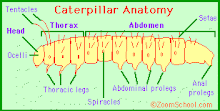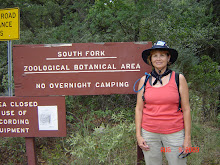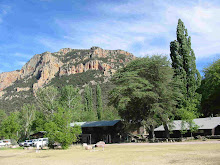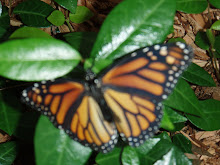What a long and educational day this has been. We awoke very early for breakfast so we could be ready for a 7:00 am talk by Dr. Lee Dyer. There were 3 aspects of this talk: #1 Diversity of interactions and latitudinal gradients, #2 Tritrophic view of specialization, #3 Climate Change.
Now you know there will be a test at the end of my notes, so pay attention. Now I know you all are laughing. You can tell that this expedition isn't a vacation by any means. Our talk this morning was on a graduate level and towards the end, we all were on information overload. Ultimately, Lee's research is based around the premise of how does the number of interactions change between species as you move through latitudinal gradients. HIs focus is on adult stages of caterpillars. Juvenile caterpillars that are collected are reared to adult in the labs at the various sites of his research (Equador, Costa Rica, Louisiana, Arizona, CA/Nevada). He does not have people at the Arizona site, so he often asks the workers there to rear his caterpillars.
We have learned that his home, along with his lab at Tulane University were destroyed by Hurricane Katrina. His son, Camden, lives with his mother and her home was not destroyed. Since he had collected data since 1994, he had a great amount prior to the habitats being destroyed. An Earthwatch team went in to New Orleans and studied the beta diversity. This means that 100% of the species had changed; which occurred with this natural disaster.
After Lee's talk, he drove all 10 of us (8 from the US and 2 from Japan) to the Sonoran Desert Museum. He promised that this would be the best introduction to the desert and he was right on! This place was phenomenal in that the cacti and other plants were identified with signs. There was a beautiful aviary, hummingbird aviary, cacti garden (even though cacti were everywhere!), a mountain lion exhibit, and an underground beaver's den where we saw them sleeping. There was a pollination garden, desert grassland and mountain woodland area. We became very heated and rested in a wonderful restaurant around 12:30. The lunch break gave us a chance to sit and cool down. It was well needed.
We shopped in a small gift shop and bought weather resistant foldout flyers on various subjects: Arizona Trees and Shrubs, Night Sky, Butterflies and Moths, and Desert Plants. After this small shopping excursion, we entered an underground tunnel area where we could observe the "life underground". This was the place where we realized how hot is really was outside. There was a sign that stated the temperature inside the tunnel and the outside temp of 114F! I have never been in such extreme temps in my life! We were all in agreement that it really felt like that outside!
Lee had left us for this portion of the day to pick up Dave Wagner and his son. Dr. Wagner is the author of the book "Eastern Caterpillars" and is beginning his book on western caterpillars, hence his reason for attending our expedition. Lee also was scouting out some collection sites for us to "practice" collecting samples. So Lee picked us up about 2:30 and drove us to a park area called Grant's Pass. He showed us the high-tech methods of collecting caterpillars. You take a stick and beat the bush while holding a collection screen underneath. Then you carefully observe everything that falls onto the screen. Lee said we have to count the number of leaves on each bush by using a very quick guestimate. Yes, we have to count the leaves in a very unscientific way. So we practiced counting and it is amazing how many different ways to count leaves. We also can just observe the stems of the shrubs for caterpillars, but this method did not prove successful. We separated into 2 groups of 5. The other group collected successfully from the acacia tree and shouted with joy upon each finding. Well, we were unsuccessful by beating the living daylights out of the ocotillo shrub. When we were disheartened, Lee said we could try collecting from the palo verde shrub. Junka discovered a very tiny movement on our screen and low and behold we finally had one tiny caterpillar. Soon we had 7 from just one shrub. It is amazing how hard you have to work to find samples. The terrain was challenging and Jared had a short slip and we soon realized how dangerous collecting caterpillars could be. He almost slid into a prickly pear that would have done much more damage than just "prick your skin". Even though I felt that I was taking care in my steps, I realized that I needed to really watch where I stepped and made sure my foothold was good.
Lee didn't want to burn us out on our first day, so we headed for the van and the cool air it would provide for us weary "bush beaters". The drive back was uneventful except for the car accident we came upon where the vehicle had actually flipped over. It appeared the driver was miraculously unhurt as he stood by talking on his cell phone.
Lee wanted to order pizzas and hang out at the hotel for another talk. I suggested we take a quick accounting of what type of pizza and soon realized I had delegated myself into calling the order to a pizza place that would deliver to the hotel. Papa John's had a deal with 4 large pizzas, 4 orders of bread sticks, 40 wings, and 3-2 liter sodas. Well, I didn't want to eat pizza on this trip, but they say when in Rome, do as the Romans do. So I ate 2 slices. But at least I didn't eat any sweets all day.
At 7:30, Lee gave another talk for about 1 hour about immature insects. And given it is very late, I will save you from the tedious notes I took during his lecture. It was interesting, but listening to the terminology he uses and vocabulary words made me feel like I was in a graduate class. Actually, this is a lecture he gives in his classes.
Our plans tomorrow are to begin our 3 hour drive southeast to the Research Station. Lee has 2 collection sites in mind that he would like us to stop at and "beat the bushes". We should all be seasoned bush beaters by the time we return home.
Well, until tomorrow night which will be at SWRS and/or Cave Creek. Good night!
Thursday, August 6, 2009
Subscribe to:
Post Comments (Atom)







































No comments:
Post a Comment